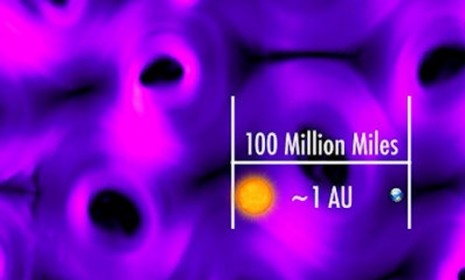The giant bubbles at the solar system's edge
NASA's twin Voyager spacecraft have given scientists a surprising new understanding of the boundaries of our solar system

A pair of NASA spacecraft on a decades-long journey in deep space have found a "big surprise": Giant magnetic bubbles churning near the outer edges of our solar system. (See an image below.) Here, a guide to the findings:
What exactly has NASA found?
Unexpected magnetic bubbles, "shaped like sausages, more than 100 million miles across," says William Harwood at CNET. Scientists had believed the structure of the magnetic field at the boundary between our solar system and interstellar space "was relatively smooth." But the data NASA has gotten from its two Voyager spacecraft suggest otherwise. "It's very bubbly as far as we can tell," says Jim Drake, a University of Maryland physicist, as quoted by National Geographic. "This entire thing is like the most bubbly part of your Jacuzzi."
The Week
Escape your echo chamber. Get the facts behind the news, plus analysis from multiple perspectives.

Sign up for The Week's Free Newsletters
From our morning news briefing to a weekly Good News Newsletter, get the best of The Week delivered directly to your inbox.
From our morning news briefing to a weekly Good News Newsletter, get the best of The Week delivered directly to your inbox.
Why are these bubbles there?
"The bubbles, scientists believe, form when the sun's magnetic field becomes warped at the edge of our solar system," says Catharine Smith at The Huffington Post. As with Earth, the sun has a magnetic field — but the sun's field reaches all the way to the edges of the solar system. "Because the sun spins, its magnetic field becomes twisted and wrinkled, a bit like a ballerina's skirt," says astronomer Merav Opher of Boston University, as quoted by The Huffington Post. "Far, far away from the sun, where the Voyagers are, the folds of the skirt bunch up."
How did NASA make this discovery?
It used a new computer model based on data received from its twin Voyager 1 and 2 spacecraft, which are some 11 billion and 9 billion miles away, respectively. The Voyager probes, which launched in 1977, are now approaching the boundary of the heliosphere — a region in space, defined by the solar wind and the sun's magnetic field, that contains our solar system. The heliosphere is like a force field that protects us "from the violent solar winds of interstellar space," says Smith at The Huffington Post.
A free daily email with the biggest news stories of the day – and the best features from TheWeek.com
And why is this important?
The new findings mean that the magnetic barrier shielding our system "may be letting in more harmful cosmic rays and energetic particles than previously thought," says Ker Than in National Geographic. Those cosmic rays "are a threat to astronauts, as they can slam into spaceflyers' cells and damage their DNA," says Space.com. But people on Earth aren't affected by these rays, as the planet's atmosphere shields against them. "The new findings could also affect astronomers' understanding about the environments around other stars," says Than in National Geographic.
(NASA)
Sources: CNET, The Huffington Post, National Geographic, Space.com


